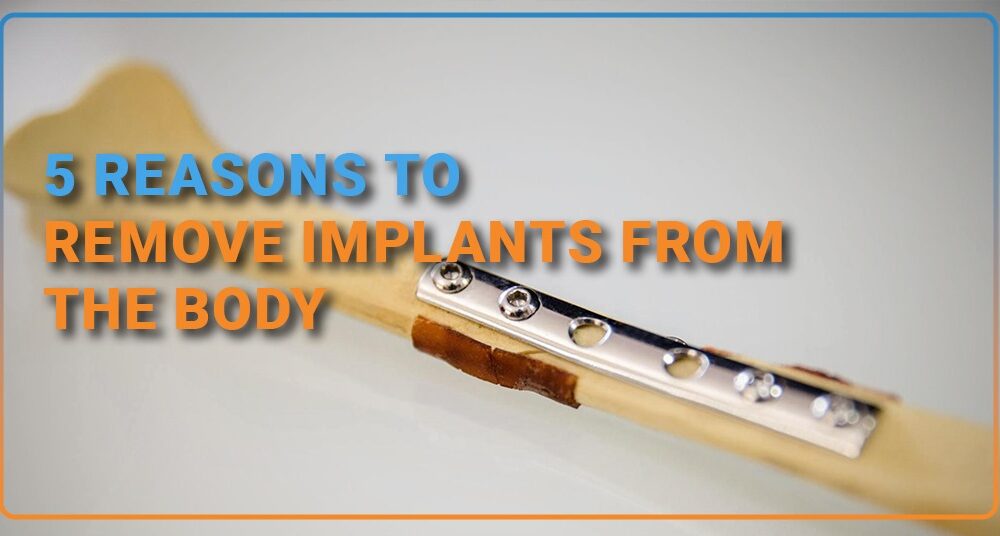Fractures often require metallic implants inside the body for fixation and treatment. The implants help in fracture union and can be in the form of wires, plates, screws, or rods. Is it mandatory to get them removed, or can we have them inside our bodies for a lifetime? What is the best time to get these implants removed from our bodies?
This article will discuss five conditions in which we advise the patient on hardware/implant removal.
1. Infection
In very few cases, the fracture site or the surgery site (they can be different, especially in nailing) may develop redness, swelling, and pain after the surgery. The patient may also have pus or watery discharge from the site. In these patients, first, we confirm the presence of infection. This can be done clinically if the signs are sure or through blood tests and tests of the pus/discharge from the wound. Usually, infection is treated through antibiotics, either as tablets or through injection. When inside the body, they travel through the blood, reach the area of infection, and kill the bacteria. The implant in the body is a non-living object with no blood supply. If we give antibiotics to these patients, they cannot reach the implant and, hence, cannot eliminate all the infections. The bacteria feel safe on the implant and start making a colony known as BIOFILM. We have to remove the implant and the biofilm to treat infection on the implant. We prioritize the treatment of infection. In the presence of infection, the fracture does not unite. So infection is one condition for which we advise implant removal.
2. Implant inside joint
Sometimes, the implant may enter the joint cavity in fractures around the joint. This can also happen later if the implant’s position gets changed due to various factors. If the implant is inside the joint, the patient has pain in the joint, and the movements are painful and restricted. This can be diagnosed on radiographs of the joint. In case of multiple plates/screws/wires, we get an exceptional CT done to check precisely which part of the implant is inside the joint. The implant inside the joint must be removed as soon as possible to prevent damage to the joint. In patients where the fracture is not fully healed, we must strike a balance between implant removal and adequate fixation strength to achieve bone union. We try to remove only the screws/wires which are inside the joint and leave the rest to help unite the fracture.
3. Prominent Implant
Certain areas in our body, such as the wrists and ankles, have fragile tissue over the bones. Sometimes, there is just a skin cover. If fractures around these areas are treated using plates and screws, they can get prominent over time. Prominent implants can also irritate the patient. In patients where nailing is done, the nail tip can irritate. In these patients, we advise implant removal after the fracture has been united. The implant removal can be a total or only the prominent part.
4. Broken Implant
A broken implant inside the body is another indication of their removal. This is advised even after the fracture is united. Sometimes, the fracture takes longer to unite, and the implant cannot tolerate the stress for extended periods. It can also happen due to substandard quality of the implant, where the implant may have impurities, and where the company does not do strength testing of the implant. Good-quality implants can also break, but that probability is lower.
5. Patient’s Will
This is the most common indication we encounter in our practice. The patient wants to get the implant removed just because it is a foreign body. The fracture is united, and the implant causes no problems for the patient.
Can you keep the implant lifelong in your body?
If your bones are nicely united and the implant is not troubling you, then yes, you can keep it. (Consult your surgeon first.)
But keep this in mind….
With time, many implants, along with their instruments, get discontinued. You may be getting the best implant available right now, but 15-20 years in the future (maybe due to medical reasons), the implant may get discontinued. If you require implant removal in the future and if the implant is discontinued, the surgery will be done with alternate instruments. The success of surgery then is reduced.
Are there any implants that get absorbed in the body?
Bio-absorbable implants are available, which get absorbed in the body and are replaced by bone over are primarily available as screws and wires and are used in the surgery of tendons and ligaments.

